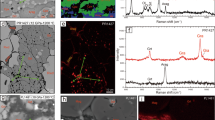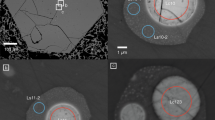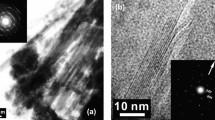Abstract
IT has become apparent during the past decade or so that CO2 is a significant component of the Earth's upper mantle. In addition to the indirect evidence including CO2 emanations from volcanoes throughout the world and the abundance of CO2 in kimberlites and carbonatites, it is now known that CO2 is ubiquitously present in xenoliths of mantle material brought up in alkalic basalts and kimberlites. This latter point was first made by Roedder1 who demonstrated that the fluid in optically visible inclusions is essentially pure CO2 under pressures as great as 5 kbar at eruptive temperatures. Such pressures provide only a minimum depth of origin, because Roedder further showed that most of the inclusions he observed are secondary, that is, they occur as arrays on healed cracks. A more recent study2 indicated pressures as high as 10 kbar in secondary inclusions. H.W.G. and Radcliffe3 found, using transmission electron microscopy (TEM), that submicroscopic fluid inclusions also occur within the crystals of mantle xenoliths, and that these bubbles have exsolved (precipitated) from solid solution. Thus, at least the CO2 now present in submicroscopic fluid inclusions is indigenous to the crystals in which it is found, and probably represents the source of crack formation and filling to produce the secondary inclusions on the way to the surface3. The effect CO2-bearing phases have on the distribution of trace elements in the mantle and during partial melting is considered here.
This is a preview of subscription content, access via your institution
Access options
Subscribe to this journal
Receive 51 print issues and online access
$199.00 per year
only $3.90 per issue
Buy this article
- Purchase on Springer Link
- Instant access to full article PDF
Prices may be subject to local taxes which are calculated during checkout
Similar content being viewed by others
References
Roedder, E. Am. Miner. 50, 1746 (1965).
Murek, B. W., Burruss, R. C. & Hollister, L. S. Am. Miner. 63, 40 (1978).
Green, H. W. & Radcliffe, S. V. Geol. Soc. Am. Bull. 86, 846 (1975).
Green, H. W. Nature phys. Sci. 238, 2 (1972).
Newton, R. C. & Sharp, W. E. Earth planet. Sci. Lett. 26, 239 (1975).
Wyllie, R. J. & Huang, W. L. Geology 3, 621 (1975).
Eggler, D. H. Geology 4, 69 (1976).
Green, H. W. EOS 59, 814 (1978).
Funkhouser, J. G. & Naughton, J. J. J. geophys. Res. 73, 4601 (1968).
Kirsten, T. Earth planet. Sci Lett. 4, 219 (1968).
Hennecke, E. W. & Manuel, O. K. Nature 257, 778 (1975).
Phinney, D., Tennyson, J. & Frick, U. J. geophys. Res. 83, 2313 (1978).
Author information
Authors and Affiliations
Rights and permissions
About this article
Cite this article
GREEN, H. Trace elements in the fluid phase of the Earth's mantle. Nature 277, 465–467 (1979). https://doi.org/10.1038/277465a0
Received:
Accepted:
Issue Date:
DOI: https://doi.org/10.1038/277465a0
This article is cited by
-
The trapped fluid phase in upper mantle xenoliths from Victoria, Australia: implications for mantle metasomatism
Contributions to Mineralogy and Petrology (1984)
-
Volatile control of contrasting trace element distributions in peralkaline granitic and volcanic rocks
Contributions to Mineralogy and Petrology (1981)
Comments
By submitting a comment you agree to abide by our Terms and Community Guidelines. If you find something abusive or that does not comply with our terms or guidelines please flag it as inappropriate.



